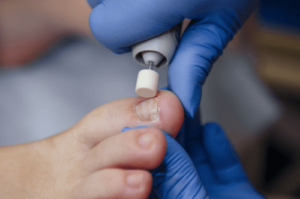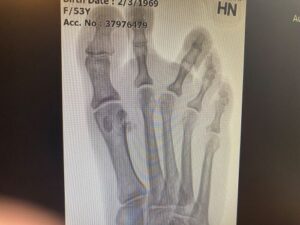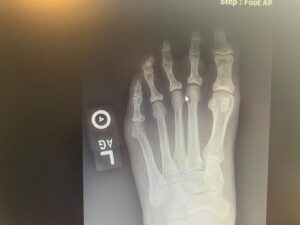Proven Strategies for Healthy Feet from a Salt Lake City Podiatrist
Here’s a not-so-fun fact: approximately 10% of the global population suffers from a toenail fungal infection at any given point in time. Given this prevalence, even if you don’t need treatment yourself, you are likely to know someone who – at this very instant – does.
The appropriate treatment for a toenail infection isn’t always as clear-cut as a quick trip to the pharmacy. SLC Podiatrist Dr. Elizabeth Auger, DPM, advises speaking with an expert on the matter before deciding on a treatment plan for any toenail fungus infection.
That said, there is nothing wrong, and, in fact, only good to gain by sharing good faith information about toenail fungal infections. Let’s talk, then, about these common health problems and what we can do about them.
What Are Toenail Fungal Infections
First of all, let’s identify what a toenail fungus infection is. The technical term for the condition is onychomycosis, and it is what happens when parasitic fungi invade the keratin and/or nail bed in the toes.
The word comes from “onycho-,” which means related to the nails, “myco-,” which means fungus, and “-osis,” which means disease.
Common Causes of Toenail Fungus Infections
The human body is actually quite adept at fending off invaders, including most fungi. Unfortunately, the nails are a more difficult part of the body to protect against microorganisms due to a lack of vascularity; no blood vessels means no blood flow in the nails.
While on the bright side, this lack of vascularity means infections are slow, it also means the causes of toenail fungal infections are usually out of reach of our body’s immune system. The most common culprits that make this area their home are dermatophytes, yeasts, and molds.
- Dermatophytes: These fungi are organisms specialized to live in keratin, making them the most common cause of onychomycosis. They thrive in moist and dark environments, such as indoor public showers and sweaty shoes.
- There are three main genera of dermatophytes (Trichophyton, Microsporum, and Epidermophyton) divided into about 40 species.
- Trichophyton rubrum is the most common dermatophyte responsible for toenail infections.
- Yeasts: Yeasts, particularly Candida species, are less common causes of onychomycosis than dermatophytes, especially because they are part of the body’s natural flora. However, in individuals with weakened immune systems, yeast populations can explode out of control, leading to infections.
-
-
- Yeasts will usually infect the skin before affecting keratin in the nails and hair.
-
- Molds: Infections by non-dermatophyte molds such as Scopulariopsis, Aspergillus, and Fusarium species are far less common than dermatophytes and yeasts, but again, they can invade the nail when the immune system is compromised. These are typically harder to treat than other fungi because of their ability to invade the non-vascular nail directly.
The specific cause of an infection will usually play a determining factor in choosing a treatment plan. For the most part, general treatments will work for a wider variety of causes if an infection is addressed early, while specialized treatment is usually needed for advanced infections.
Treating Toenail Fungus
Toenail fungal infections are generally known to be stubborn, but they aren’t impossible to get rid of. Depending on the level of infection, you may be able to handle them on your own at home or with a quick trip to a pharmacy.
That said, self-treatment is not always possible. Your doctor may prescribe more potent medications or suggest procedures to get rid of persistent fungal problems.
Home Remedies for Toenail Fungus
While most doctors won’t recommend these treatments without first getting a medical opinion, they can be effective (and cost-effective) on their own. The caveat to keep in mind is that you need to have a strong immune system, to begin with, so as not to need more potent treatments.
- Tea tree oil: While only possessing mild antifungal properties, tea tree oil is a powerful antioxidant whose real value in treating toenail infections lies in its ability to aid in healing damage that fungi cause. Most physicians will recommend supplementing treatment with other antifungals in addition to tea tree oil.
- Vinegar baths/soaks: Acidic environments are generally hostile to microorganisms, including many species of dermatophytes. As far as acids go, vinegar is one of the most accessible and safest chemicals one can use for an acid bath.
- Camphor: Camphor is toxic to many fungal species and is readily accessible as the active ingredient in Vicks VapoRub and other similar topical ointments. The chemical disrupts processes in vulnerable cells, causing them to break down.
- Garlic: Plants as a whole are infamous for adapting to threats via biological warfare; the garlic plant—and its cloves in particular—produce a sulfur-containing compound called allicin, which destroys fungal cells on a chemical level. Patients can try applying garlic directly to the affected area or increasing their garlic intake in their diets.
Over-the-Counter (OTC) Treatments
OTC treatments are, more often than not, more effective than home remedies. They are, of course, more expensive than treatments you can come up with at home, but they have the advantage of being purposefully formulated to target general infections.
- Generic antifungals: The most common OTC antifungals include clotrimazole and terbinafine. These are usually topical and applied directly onto the nail but may require additional medication for anything more severe than a superficial infection.
- Nail lacquers: Some cosmetic nail products are formulated with medication. These are typically long-term treatments designed to penetrate the matrix of the nail over the course of several months in order to kill the fungus.
- Urea: Urea has the distinct function of softening and thinning the nail matrix, allowing other medications to penetrate further into it. Creams that include urea often have other active ingredients that deal with the infection itself.
Prescription Treatments
The most severe cases of toenail infections almost always require specialized treatment. Prescriptions are needed for these treatments because of potential risks and side effects as a tradeoff for their higher success rate with difficult-to-treat cases.
- Oral Antifungals: Some antifungal drugs, such as terbinafine or itraconazole (Lamisil and Sporanox, respectively), are able to treat fungal infections from inside the body by being transported into the nail bed by the circulatory system. These drugs poison the fungal infestation but should only be taken as prescribed in order to avoid side effects such as liver toxicity.
-
-
- Also, note that these drugs still take several weeks to several months to take effect as the treated nail matrix needs time to grow out of the nail bed.
-
- Topical Prescriptions: Typically used in combination with OTC medications, topical prescription treatments are potent enough to kill mature fungi and their spores as well, potentially preventing the resurgence and transmission of the infection. Drugs such as efinaconazole are usually prescribed for daily use over the course of up to six months.
- Laser Therapy: The focused light and heat of a laser can kill most organic tissue, with effectiveness increasing the simpler an organism is. While the treatment is expensive, controlled lasers are harmless and painless to most humans while simultaneously being lethal to fungal cells.
- Surgical Procedures: If an infection does not respond to other treatments, physicians may recommend partial or total removal of infected toenails. Surgery is considered a drastic last resort, so most people don’t have to worry about reaching this point, however.
Toenail Fungus Complications
Fungi, living creatures that they are, do what all living things do: they feed and grow. In the case of toenail fungi, this feeding and growing will eventually take its toll on the nail, leading to increased damage over a long period of time.
This damage to the toenail manifests in different ways, but here are some common complications associated with toenail fungi.
Brittle Nails
In order to break down the tough proteins found in our nails, parasitic fungi produce chemicals called keratinase. These enzymes weaken the structure of keratin to make it easier for the colony to consume.
Because nails serve a protective and reinforcing function, having weakened nails compromises your ability to properly walk or stand, let alone perform heavy lifting or other manual tasks.
Worse still, partially broken nails can damage the soft tissue of your toes, opening up the possibility of more dangerous bacterial and viral infections should any microbes enter the wound (but we’ll get to that).
Thickened Nails
Fungi breaking down keratin for sustenance sends signals to the brain that that specific body part is in danger. The body’s response is to produce more keratin to rebuild the damaged nail, paradoxically creating thicker nails.
If the fungal colony does not spread too quickly, this overproduction of keratin can lead to nails that are tough and often distorted in appearance. The problem is exacerbated by the accumulation of degraded keratin and, sometimes, fungal and skin cells under the nail caused by the body fighting back against the infection.
Paradoxically, it is possible to have nails that are both thicker and weaker than normal.
Fungal Outbreaks
While nail fungi will happily gorge on the nail, you have to remember that they’re really after keratin. This is most commonly found in our nails, which is why fungi prefer to form colonies there, but it is also found in every strand of hair on our bodies… and we are covered in hair.
A severe enough fungal infection can lead to the colony spreading to other nails or even adjacent skin as the keratin supply diminishes at the original site of infection.
Bacterial Infection
Different species of bacteria can be found in the same environment as fungal colonies, and there are varying relationships between these life forms, depending on the species. The way they interact with each other can range from mutualistic (the presence of one helps the other) to antagonistic (they compete for the same resources).
Regardless of the relationship between bacteria and fungi, however, it is usually bad news for the human body.
If they benefit from each other, they help each other proliferate, making it more difficult to clear the infection. If they compete against each other, they can speed up the rate at which the nail degrades and leave more toxic byproducts in their wake as they fight for dominance.
What we call polymicrobial infections can be extremely difficult to address, as a treatment for one organism might not necessarily work for the other. In some cases, a colony of fungi might even serve as a barrier protecting bacteria from medication.
Multiple treatments are often required to clear out these infections, and only after a thorough assessment by a podiatrist or other health professional, purely out of the complexity of interactions between multiple drugs and multiple microorganisms.
How to Know When Toenail Fungus Is Dying
Several factors involving the nature of toenails and fungal infections can make it difficult to tell when a fungal infection is going away. Looking back at the aforementioned indicators of nail health, it is possible to make fairly accurate guesses on your own, but there are certain difficulties.
Slow Growth Rate
Toenails grow just a little over one millimeter a month, which is less than half the rate at which fingernails grow. Unfortunately, this means it can take a long time before any visible improvement can be observed, even longer if the growth rate is further slowed by the infection.
This slow rate of nail growth also makes it hard to identify whether or not treatment is working. Improved hygiene, nutrition, and medications are all assumed to work based on common medical practice, but you typically won’t notice the effects if you count down the days yourself
For the most part, you will have to wait for new, healthy nails to grow out whilst trimming away damaged areas. Keep your doctor informed during your treatment so they will know how to adjust accordingly.
Delayed Healing
Another problem with treating toenail infections is the fact that the toenails are not vascularized. The nail matrix – the part that creates the keratinized nail plate – is, but the plate itself does not have any easy means for the body to deliver material to it.
This is why the immune system has a difficult time fighting off fungal infections. It is also why medications take time to work.
Even topical antifungals do not take immediate effect against serious infections because the nail is meant to be difficult to penetrate in order to serve its protective function. Medications have to enter the nail before they can start affecting the fungal colony.
Environmental Factors
Most people wear shoes on a near-daily, if not daily, basis, and this means subjecting the feet to dark and damp spaces where fungi thrive. The environment inside shoes can also make it difficult to tell whether or not an infection is improving, even if the fungi have been eliminated, just because the moisture can make the damage look worse than it is.
Persistence of Fungal Spores
While the other factors on this list have the potential to make it difficult to identify improvement, fungal spores are the opposite in that they can fool you into thinking your condition has improved.
Spores are a natural part of a fungus’s life cycle. They are typically hardier than the main body of a fungus and have evolved to survive harsh environments for prolonged periods until more favorable conditions arise for their growth.
For context, fungal spores can survive extreme heat and cold, dehydration, many kinds of chemical agents, and even UV radiation. Some species can remain dormant for years, waiting for the right time and place to start a colony.
This obviously is not good for anyone with a toenail infection, as it means even if you do see improvement early on, there is a good chance of reinfection if you get careless and decide to stop treatment.
To make matters worse, it is possible for spores that survive a treatment to form a colony with resistance to that treatment in the future. Fungi do not typically adapt as fast as bacteria do, as their complex mechanisms are more gradual (vs. bacteria that can transfer genes to quickly develop resistances), but any degree of resistance at all is a bad thing for us.
This is the same problem that doctors face with many antimicrobial medications today, especially antibiotics. Patients see early signs of improvement and decide they are completely healed without consulting their doctor, and after a while, the infection resurges in a form more resistant to treatment than before.
How to Prevent Toenail Fungus From Coming Back
Once you start seeing signs that an infection has cleared, the first thing you should do is see your foot doctor to confirm it. Again, you don’t want to stop treatment without first being sure that the entire colony has been eradicated, and your doctor can determine this for you.
If your doctor gives you the all-clear, the most important thing to keep in mind in order to prevent reinfection is to monitor your lifestyle. This means keeping tabs on your hygiene, diet, exercise, and even sleep schedule.
In addition to this, it’s generally good practice to have regular cleaning and disinfection of areas in your home where fungi might gather, such as bathroom tiles or old and musty cabinets. Having antifungal powder ready to disinfect the inside of your shoes is also useful.
Prevent Toenail Fungus With the Help of SLC Podiatrist Dr. Elizabeth Auger, DPM
For 25 years, Salt Lake City Podiatrist Dr. Elizabeth Auger, DPM, has served the entire SLC community with three established clinics in Mill Creek, Sandy, and West Jordan. She offers professional treatment and healthcare plans to address patients’ foot problems.
Whether it’s custom orthotics, arthritis, toenail fungus, or any other foot issue in between, Dr. Auger is here to help with personalized treatment plans to get your health back in line with your lifestyle. Same-day appointments mean you don’t have to wait to get your feet back in shape.





